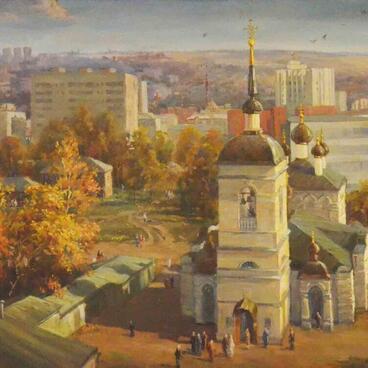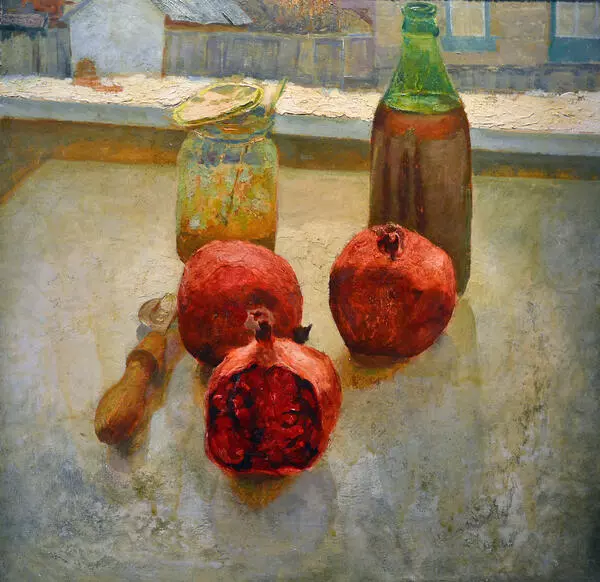Marat Semyonovich Shanin was one of the artists who laid the foundation for the Mordovian fine arts tradition. The artist is a fine lyricist, in love with the beauty of the Mordovian land. The national theme in his works is revealed through specific images of people, through vivid individual features, the originality of the appearance and unique personality traits of the models.
Marat Semyonovich Shanin, People’s Artist of the Republic of Mordovia, painter, graphic artist, and founder of the creative dynasty of the Shanins, was born in Penza, graduated from the Penza Art School and the Kharkov Art Institute. During his studies he married the artist Lyubov Trembachevskaya, and the family of artists moved from Penza to Saransk. Marat Shanin was the first director of the Sychkov Art School, where he taught painting and drawing. His favorite genres of art were genre painting, landscapes, still lifes, and portraits. His contemporaries and professionals compared the artist’s academic works to paintings by Ilya Repin “for their purity, clarity of brushstroke, coloring, and realism…”
In “Christmas Fortune Telling”, the artist gives a new perspective on the subject, which has been celebrated in the poems of Alexander Pushkin and Vasily Zhukovsky and in the paintings of Alexey Venetsianov, Konstantin Makovsky, Karl Bryullov, Konstantin Trutovsky, Ivan Kramskoy, and many others.
Yuletide evenings in Russia began immediately after Christmas and lasted until the Epiphany, celebrated on January 19 of the new style. Yuletide was the critical and most fearful period, when evil spirits were especially strong. The sacrament of divination was considered frightening due to the fact that the world beyond was involved in the process, and the evil forces had a real opportunity to take the fortune-teller to the other world. All divination mysteries were performed under the cover of night, close to midnight.
The painting depicts two young women in folk costumes sitting at a round table against the dark background of the room. While expecting marriage, each girl tried to find out, at least with the help of evil forces, who was destined to marry her and what kind of life awaited her. Christmas and Yuletide fortune-telling before the Epiphany remain a popular custom to this day. Unmarried girls still want to look into the future and find out about their betrothed.
Marat Semyonovich Shanin, People’s Artist of the Republic of Mordovia, painter, graphic artist, and founder of the creative dynasty of the Shanins, was born in Penza, graduated from the Penza Art School and the Kharkov Art Institute. During his studies he married the artist Lyubov Trembachevskaya, and the family of artists moved from Penza to Saransk. Marat Shanin was the first director of the Sychkov Art School, where he taught painting and drawing. His favorite genres of art were genre painting, landscapes, still lifes, and portraits. His contemporaries and professionals compared the artist’s academic works to paintings by Ilya Repin “for their purity, clarity of brushstroke, coloring, and realism…”
In “Christmas Fortune Telling”, the artist gives a new perspective on the subject, which has been celebrated in the poems of Alexander Pushkin and Vasily Zhukovsky and in the paintings of Alexey Venetsianov, Konstantin Makovsky, Karl Bryullov, Konstantin Trutovsky, Ivan Kramskoy, and many others.
Yuletide evenings in Russia began immediately after Christmas and lasted until the Epiphany, celebrated on January 19 of the new style. Yuletide was the critical and most fearful period, when evil spirits were especially strong. The sacrament of divination was considered frightening due to the fact that the world beyond was involved in the process, and the evil forces had a real opportunity to take the fortune-teller to the other world. All divination mysteries were performed under the cover of night, close to midnight.
The painting depicts two young women in folk costumes sitting at a round table against the dark background of the room. While expecting marriage, each girl tried to find out, at least with the help of evil forces, who was destined to marry her and what kind of life awaited her. Christmas and Yuletide fortune-telling before the Epiphany remain a popular custom to this day. Unmarried girls still want to look into the future and find out about their betrothed.



